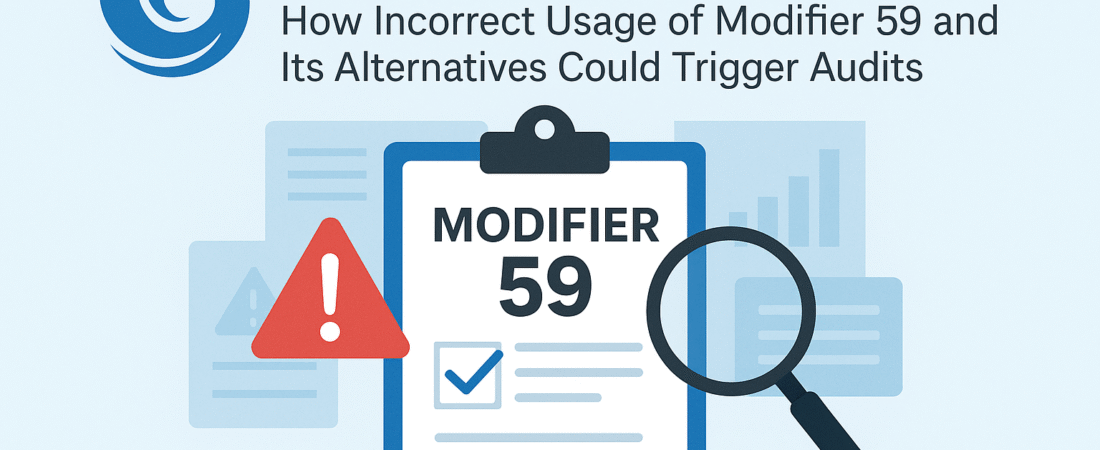Your cart is currently empty!
In the world of Medicare billing, a single keystroke can separate clean reimbursement from costly recoupment.
Few billing issues generate as much confusion—or as many denials—as improper modifier usage. Among the most misused? Modifier 59, often applied in a last-ditch attempt to override Medicare edits.
As a Medicare billing strategist with over 25 years of experience, I’ve seen firsthand how modifier misuse silently erodes revenue—and more critically, how it raises red flags that can invite Medicare audits, prepayment reviews, or even fraud investigations.
Let’s unpack what you need to know to stop modifier madness before it costs your organization.
🔍 Why Modifier 59 Is So Misunderstood
Modifier 59 is intended to indicate that a procedure or service was distinct and independent from another service performed on the same day.
The problem? It’s often slapped on claims automatically to bypass NCCI (National Correct Coding Initiative) edits—without supporting documentation or true clinical justification.
CMS has openly warned against the overuse of Modifier 59, calling it one of the most abused modifiers in outpatient claims.
⚠️ 3 Risky Scenarios Where Modifier 59 Triggers Issues
1. Overriding NCCI PTP Edits Without Justification
What happens: Providers bill CPT codes that are typically bundled, then add Modifier 59 to “separate” them. Why it’s risky: Without clear documentation, this is a compliance red flag and a common audit trigger.
2. Using Modifier 59 Instead of More Specific “X” Modifiers
What happens: Providers default to 59 even though CMS recommends the more precise subset modifiers:
- XE – Separate Encounter
- XS – Separate Structure
- XP – Separate Practitioner
- XU – Unusual Non-Overlapping Service Why it’s risky: Continued use of Modifier 59 in place of these more descriptive codes could be seen as intentional miscoding.
3. No Supporting Documentation in the Medical Record
What happens: Claims are submitted with Modifier 59, but charts lack language to prove services were distinct. Why it’s risky: If audited, these claims could result in full recoupment and trigger broader compliance reviews.
✅ What You Should Do Instead
✔ Implement a Modifier Usage Policy
Create internal documentation policies outlining when modifiers like 59, 25, and 91 are appropriate. Provide examples tied to your specialty.
✔ Train Coders and Clinicians Together
Coders often apply modifiers, but clinical documentation is what justifies them. Joint training aligns language and coding intent.
✔ Use “X” Modifiers When Applicable
CMS explicitly prefers XE, XS, XP, and XU over Modifier 59 where appropriate. Your billing software should prompt for these choices.
✔ Audit Your Modifier Usage Quarterly
Pull a random sample of claims using Modifier 59. Compare them to clinical notes. Ask: Would this stand up in an audit?
✔ Stay Updated on CMS and MAC Guidance
Modifier policies evolve. Bookmark your MAC’s website and set alerts for coding changes, especially NCCI edit table updates.
💡 Pro Tip: How One Clinic Reduced Denials by 41%
A cardiology group I consulted with had a 28% denial rate on outpatient procedures—largely due to misuse of Modifier 59. We:
- Mapped common NCCI pairings
- Trained coders on XE/XS/XU usage
- Built a claim scrubber rule that prompted documentation review when 59 was applied
Results: Within 90 days, they reduced modifier-related denials by 41% and passed a Medicare post-payment audit with zero findings.
🧠 Bottom Line
Modifier 59 is a powerful tool—but it’s not a get-out-of-denial-free card.
Used correctly, it clarifies complexity. Misused, it flags your organization for deeper review. Every time you use Modifier 59 (or don’t use it when you should), you’re making a compliance choice.
📣 Let’s Clean Up Modifier Confusion—Before CMS Comes Knocking
Want help auditing your modifier usage or training your team on “X” modifier transitions?

